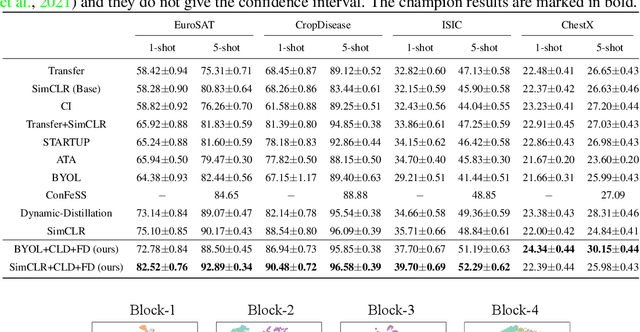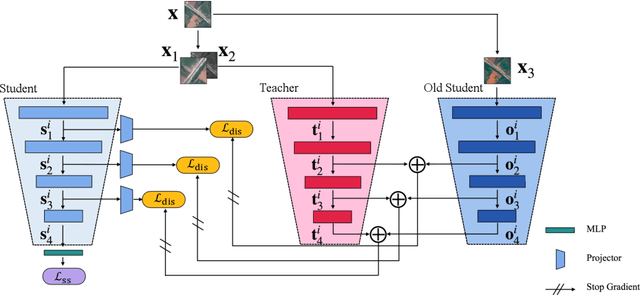Asako Kanezaki
Modality Selection and Skill Segmentation via Cross-Modality Attention
Apr 20, 2025Abstract:Incorporating additional sensory modalities such as tactile and audio into foundational robotic models poses significant challenges due to the curse of dimensionality. This work addresses this issue through modality selection. We propose a cross-modality attention (CMA) mechanism to identify and selectively utilize the modalities that are most informative for action generation at each timestep. Furthermore, we extend the application of CMA to segment primitive skills from expert demonstrations and leverage this segmentation to train a hierarchical policy capable of solving long-horizon, contact-rich manipulation tasks.
FlowLoss: Dynamic Flow-Conditioned Loss Strategy for Video Diffusion Models
Apr 20, 2025Abstract:Video Diffusion Models (VDMs) can generate high-quality videos, but often struggle with producing temporally coherent motion. Optical flow supervision is a promising approach to address this, with prior works commonly employing warping-based strategies that avoid explicit flow matching. In this work, we explore an alternative formulation, FlowLoss, which directly compares flow fields extracted from generated and ground-truth videos. To account for the unreliability of flow estimation under high-noise conditions in diffusion, we propose a noise-aware weighting scheme that modulates the flow loss across denoising steps. Experiments on robotic video datasets suggest that FlowLoss improves motion stability and accelerates convergence in early training stages. Our findings offer practical insights for incorporating motion-based supervision into noise-conditioned generative models.
Zero-Shot Peg Insertion: Identifying Mating Holes and Estimating SE(2) Poses with Vision-Language Models
Mar 08, 2025Abstract:Achieving zero-shot peg insertion, where inserting an arbitrary peg into an unseen hole without task-specific training, remains a fundamental challenge in robotics. This task demands a highly generalizable perception system capable of detecting potential holes, selecting the correct mating hole from multiple candidates, estimating its precise pose, and executing insertion despite uncertainties. While learning-based methods have been applied to peg insertion, they often fail to generalize beyond the specific peg-hole pairs encountered during training. Recent advancements in Vision-Language Models (VLMs) offer a promising alternative, leveraging large-scale datasets to enable robust generalization across diverse tasks. Inspired by their success, we introduce a novel zero-shot peg insertion framework that utilizes a VLM to identify mating holes and estimate their poses without prior knowledge of their geometry. Extensive experiments demonstrate that our method achieves 90.2% accuracy, significantly outperforming baselines in identifying the correct mating hole across a wide range of previously unseen peg-hole pairs, including 3D-printed objects, toy puzzles, and industrial connectors. Furthermore, we validate the effectiveness of our approach in a real-world connector insertion task on a backpanel of a PC, where our system successfully detects holes, identifies the correct mating hole, estimates its pose, and completes the insertion with a success rate of 88.3%. These results highlight the potential of VLM-driven zero-shot reasoning for enabling robust and generalizable robotic assembly.
OP-Align: Object-level and Part-level Alignment for Self-supervised Category-level Articulated Object Pose Estimation
Aug 29, 2024


Abstract:Category-level articulated object pose estimation focuses on the pose estimation of unknown articulated objects within known categories. Despite its significance, this task remains challenging due to the varying shapes and poses of objects, expensive dataset annotation costs, and complex real-world environments. In this paper, we propose a novel self-supervised approach that leverages a single-frame point cloud to solve this task. Our model consistently generates reconstruction with a canonical pose and joint state for the entire input object, and it estimates object-level poses that reduce overall pose variance and part-level poses that align each part of the input with its corresponding part of the reconstruction. Experimental results demonstrate that our approach significantly outperforms previous self-supervised methods and is comparable to the state-of-the-art supervised methods. To assess the performance of our model in real-world scenarios, we also introduce a new real-world articulated object benchmark dataset.
Zero-shot Degree of Ill-posedness Estimation for Active Small Object Change Detection
May 10, 2024Abstract:In everyday indoor navigation, robots often needto detect non-distinctive small-change objects (e.g., stationery,lost items, and junk, etc.) to maintain domain knowledge. Thisis most relevant to ground-view change detection (GVCD), a recently emerging research area in the field of computer vision.However, these existing techniques rely on high-quality class-specific object priors to regularize a change detector modelthat cannot be applied to semantically nondistinctive smallobjects. To address ill-posedness, in this study, we explorethe concept of degree-of-ill-posedness (DoI) from the newperspective of GVCD, aiming to improve both passive and activevision. This novel DoI problem is highly domain-dependent,and manually collecting fine-grained annotated training datais expensive. To regularize this problem, we apply the conceptof self-supervised learning to achieve efficient DoI estimationscheme and investigate its generalization to diverse datasets.Specifically, we tackle the challenging issue of obtaining self-supervision cues for semantically non-distinctive unseen smallobjects and show that novel "oversegmentation cues" from openvocabulary semantic segmentation can be effectively exploited.When applied to diverse real datasets, the proposed DoI modelcan boost state-of-the-art change detection models, and it showsstable and consistent improvements when evaluated on real-world datasets.
Leveraging Large Language Model-based Room-Object Relationships Knowledge for Enhancing Multimodal-Input Object Goal Navigation
Mar 21, 2024Abstract:Object-goal navigation is a crucial engineering task for the community of embodied navigation; it involves navigating to an instance of a specified object category within unseen environments. Although extensive investigations have been conducted on both end-to-end and modular-based, data-driven approaches, fully enabling an agent to comprehend the environment through perceptual knowledge and perform object-goal navigation as efficiently as humans remains a significant challenge. Recently, large language models have shown potential in this task, thanks to their powerful capabilities for knowledge extraction and integration. In this study, we propose a data-driven, modular-based approach, trained on a dataset that incorporates common-sense knowledge of object-to-room relationships extracted from a large language model. We utilize the multi-channel Swin-Unet architecture to conduct multi-task learning incorporating with multimodal inputs. The results in the Habitat simulator demonstrate that our framework outperforms the baseline by an average of 10.6% in the efficiency metric, Success weighted by Path Length (SPL). The real-world demonstration shows that the proposed approach can efficiently conduct this task by traversing several rooms. For more details and real-world demonstrations, please check our project webpage (https://sunleyuan.github.io/ObjectNav).
Linking Vision and Multi-Agent Communication through Visible Light Communication using Event Cameras
Feb 15, 2024Abstract:Various robots, rovers, drones, and other agents of mass-produced products are expected to encounter scenes where they intersect and collaborate in the near future. In such multi-agent systems, individual identification and communication play crucial roles. In this paper, we explore camera-based visible light communication using event cameras to tackle this problem. An event camera captures the events occurring in regions with changes in brightness and can be utilized as a receiver for visible light communication, leveraging its high temporal resolution. Generally, agents with identical appearances in mass-produced products are visually indistinguishable when using conventional CMOS cameras. Therefore, linking visual information with information acquired through conventional radio communication is challenging. We empirically demonstrate the advantages of a visible light communication system employing event cameras and LEDs for visual individual identification over conventional CMOS cameras with ArUco marker recognition. In the simulation, we also verified scenarios where our event camera-based visible light communication outperforms conventional radio communication in situations with visually indistinguishable multi-agents. Finally, our newly implemented multi-agent system verifies its functionality through physical robot experiments.
Cross-Level Distillation and Feature Denoising for Cross-Domain Few-Shot Classification
Nov 04, 2023



Abstract:The conventional few-shot classification aims at learning a model on a large labeled base dataset and rapidly adapting to a target dataset that is from the same distribution as the base dataset. However, in practice, the base and the target datasets of few-shot classification are usually from different domains, which is the problem of cross-domain few-shot classification. We tackle this problem by making a small proportion of unlabeled images in the target domain accessible in the training stage. In this setup, even though the base data are sufficient and labeled, the large domain shift still makes transferring the knowledge from the base dataset difficult. We meticulously design a cross-level knowledge distillation method, which can strengthen the ability of the model to extract more discriminative features in the target dataset by guiding the network's shallow layers to learn higher-level information. Furthermore, in order to alleviate the overfitting in the evaluation stage, we propose a feature denoising operation which can reduce the feature redundancy and mitigate overfitting. Our approach can surpass the previous state-of-the-art method, Dynamic-Distillation, by 5.44% on 1-shot and 1.37% on 5-shot classification tasks on average in the BSCD-FSL benchmark. The implementation code will be available at https://github.com/jarucezh/cldfd.
Tactile Estimation of Extrinsic Contact Patch for Stable Placement
Sep 25, 2023Abstract:Precise perception of contact interactions is essential for the fine-grained manipulation skills for robots. In this paper, we present the design of feedback skills for robots that must learn to stack complex-shaped objects on top of each other. To design such a system, a robot should be able to reason about the stability of placement from very gentle contact interactions. Our results demonstrate that it is possible to infer the stability of object placement based on tactile readings during contact formation between the object and its environment. In particular, we estimate the contact patch between a grasped object and its environment using force and tactile observations to estimate the stability of the object during a contact formation. The contact patch could be used to estimate the stability of the object upon the release of the grasp. The proposed method is demonstrated on various pairs of objects that are used in a very popular board game.
Point Anywhere: Directed Object Estimation from Omnidirectional Images
Aug 02, 2023Abstract:One of the intuitive instruction methods in robot navigation is a pointing gesture. In this study, we propose a method using an omnidirectional camera to eliminate the user/object position constraint and the left/right constraint of the pointing arm. Although the accuracy of skeleton and object detection is low due to the high distortion of equirectangular images, the proposed method enables highly accurate estimation by repeatedly extracting regions of interest from the equirectangular image and projecting them onto perspective images. Furthermore, we found that training the likelihood of the target object in machine learning further improves the estimation accuracy.
 Add to Chrome
Add to Chrome Add to Firefox
Add to Firefox Add to Edge
Add to Edge